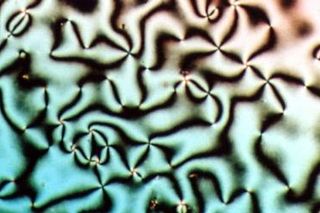Related Research Articles

Liquid crystal (LC) is a state of matter whose properties are between those of conventional liquids and those of solid crystals. For example, a liquid crystal may flow like a liquid, but its molecules may be oriented in a crystal-like way. There are many types of LC phases, which can be distinguished by their optical properties. The contrasting textures arise due to molecules within one area of material ("domain") being oriented in the same direction but different areas having different orientations. LC materials may not always be in a LC state of matter.

Organic electronics is a field of materials science concerning the design, synthesis, characterization, and application of organic molecules or polymers that show desirable electronic properties such as conductivity. Unlike conventional inorganic conductors and semiconductors, organic electronic materials are constructed from organic (carbon-based) molecules or polymers using synthetic strategies developed in the context of organic chemistry and polymer chemistry.

An organic light-emitting diode, also known as organic electroluminescentdiode, is a light-emitting diode (LED) in which the emissive electroluminescent layer is a film of organic compound that emits light in response to an electric current. This organic layer is situated between two electrodes; typically, at least one of these electrodes is transparent. OLEDs are used to create digital displays in devices such as television screens, computer monitors, and portable systems such as smartphones and handheld game consoles. A major area of research is the development of white OLED devices for use in solid-state lighting applications.

A flat-panel display (FPD) is an electronic display used to display visual content such as text or images. It is present in consumer, medical, transportation, and industrial equipment.

Poly(p-phenylene vinylene) is a conducting polymer of the rigid-rod polymer family. PPV is the only polymer of this type that can be processed into a highly ordered crystalline thin film. PPV and its derivatives are electrically conducting upon doping. Although insoluble in water, its precursors can be manipulated in aqueous solution. The small optical band gap and its bright yellow fluorescence makes PPV a candidate in applications such as light-emitting diodes (LED) and photovoltaic devices. Moreover, PPV can be doped to form electrically conductive materials. Its physical and electronic properties can be altered by the inclusion of functional side groups.
Organic semiconductors are solids whose building blocks are pi-bonded molecules or polymers made up by carbon and hydrogen atoms and – at times – heteroatoms such as nitrogen, sulfur and oxygen. They exist in form of molecular crystals or amorphous thin films. In general, they are electrical insulators, but become semiconducting when charges are either injected from appropriate electrodes, upon doping or by photoexcitation.
The columnar phase is a class of mesophases in which molecules assemble into cylindrical structures to act as mesogens. Originally, these kinds of liquid crystals were called discotic liquid crystals or bowlic liquid crystals because the columnar structures are composed of flat-shaped discotic or bowl-shaped molecules stacked one-dimensionally. Since recent findings provide a number of columnar liquid crystals consisting of non-discoid mesogens, it is more common now to classify this state of matter and compounds with these properties as columnar liquid crystals.
A biaxial nematic is a spatially homogeneous liquid crystal with three distinct optical axes. This is to be contrasted to a simple nematic, which has a single preferred axis, around which the system is rotationally symmetric. The symmetry group of a biaxial nematic is i.e. that of a rectangular right parallelepiped, having 3 orthogonal axes and three orthogonal mirror planes. In a frame co-aligned with optical axes the second rank order parameter tensor of a biaxial nematic has the form

A flexible organic light-emitting diode (FOLED) is a type of organic light-emitting diode (OLED) incorporating a flexible plastic substrate on which the electroluminescent organic semiconductor is deposited. This enables the device to be bent or rolled while still operating. Currently the focus of research in industrial and academic groups, flexible OLEDs form one method of fabricating a rollable display.

Triphenylene is an organic compound with the formula (C6H4)3. A flat polycyclic aromatic hydrocarbon (PAH), it consists of four fused benzene rings. Triphenylene has delocalized 18-π-electron systems based on a planar structure, corresponding to the symmetry group D3h. It is a white or colorless solid.

Perylene or perilene is a polycyclic aromatic hydrocarbon with the chemical formula C20H12, occurring as a brown solid. It or its derivatives may be carcinogenic, and it is considered to be a hazardous pollutant. In cell membrane cytochemistry, perylene is used as a fluorescent lipid probe. It is the parent compound of a class of rylene dyes.

Pentacene is a polycyclic aromatic hydrocarbon consisting of five linearly-fused benzene rings. This highly conjugated compound is an organic semiconductor. The compound generates excitons upon absorption of ultra-violet (UV) or visible light; this makes it very sensitive to oxidation. For this reason, this compound, which is a purple powder, slowly degrades upon exposure to air and light.

Diindenoperylene (DIP) is an organic semiconductor which receives attention because of its potential application in optoelectronics (solar cells, OLEDs) and electronics (RFID tags). DIP is a planar perylene derivative with two indeno-groups attached to opposite sides of the perylene core. Its chemical formula is C32H16, the full chemical name is diindeno[1,2,3-cd:1',2',3'-lm]perylene. Its chemical synthesis has been described.

Polydioctylfluorene (PFO) is an organic compound, a polymer of 9,9-dioctylfluorene, with formula (C13H6(C8H17)2)n. It is an electroluminescent conductive polymer that characteristically emits blue light. Like other polyfluorene polymers, it has been studied as a possible material for light-emitting diodes.

A quantum dot display is a display device that uses quantum dots (QD), semiconductor nanocrystals which can produce pure monochromatic red, green, and blue light.

Polyfluorene is a polymer with formula (C13H8)n, consisting of fluorene units linked in a linear chain — specifically, at carbon atoms 2 and 7 in the standard fluorene numbering. It can also be described as a chain of benzene rings linked in para positions with an extra methylene bridge connecting every pair of rings.
Mark E. Thompson is a Californian chemistry academic who has worked with OLEDs.

Contorted aromatics or more precisely contorted polycyclic aromatic hydrocarbons are polycyclic aromatic hydrocarbons (PAHs) in which the fused aromatic molecules deviate from the usual planarity.

Klaus Müllen is a German chemist working in the fields of polymer chemistry, supramolecular chemistry and nanotechnology. He is known for the synthesis and exploration of the properties of graphene-like nanostructures and their potential applications in organic electronics.
Ellen Moons is a Belgian materials scientist who is a professor at Karlstad University. Her research considers the organisation of molecules and materials in thin films. She is mainly interested in organic and hybrid materials for solution processed photovoltaics.
References
- ↑ Laschat, S.; Baro, A.; Steinke, N.; Giesselmann, F.; Hägele, C.; Scalia, G.; Judele, R.; Kapatsina, E.; Sauer, S.; Schreivogel, A.; Tosoni, M. Angewandte Chemie International Edition 2007, 46, 4832-4887.
- 1 2 Schmidt-Mende, L; Fechtenkötter, A; Müllen, K; Friend, R.H; MacKenzie, J.D (2002). "Efficient organic photovoltaics from soluble discotic liquid crystalline materials". Physica E: Low-dimensional Systems and Nanostructures. Elsevier BV. 14 (1–2): 263–267. doi:10.1016/s1386-9477(02)00400-9. ISSN 1386-9477.
- 1 2 Seguy, I.; Jolinat, P.; Destruel, P.; Farenc, J.; Mamy, R.; Bock, H.; Ip, J.; Nguyen, T. P. (2001-05-15). "Red organic light emitting device made from triphenylene hexaester and perylene tetraester". Journal of Applied Physics. AIP Publishing. 89 (10): 5442–5448. doi:10.1063/1.1365059. ISSN 0021-8979.
- ↑ Steinhart, Martin; Zimmermann, Sven; Göring, Petra; Schaper, Andreas K.; Gösele, Ulrich; Weder, Christoph; Wendorff, Joachim H. (2005). "Liquid Crystalline Nanowires in Porous Alumina: Geometric Confinement versus Influence of Pore Walls". Nano Letters. American Chemical Society (ACS). 5 (3): 429–434. doi:10.1021/nl0481728. ISSN 1530-6984. PMID 15755089.
- ↑ Kreouzis, T.; Donovan, K. J.; Boden, N.; Bushby, R. J.; Lozman, O. R.; Liu, Q. The Journal of Chemical Physics 2001, 114, 1797-1802.
- ↑ "Sony's 1,000,000:1 contrast ratio 27-inch OLED HDTV". Engadget.com. Retrieved 2018-07-19.